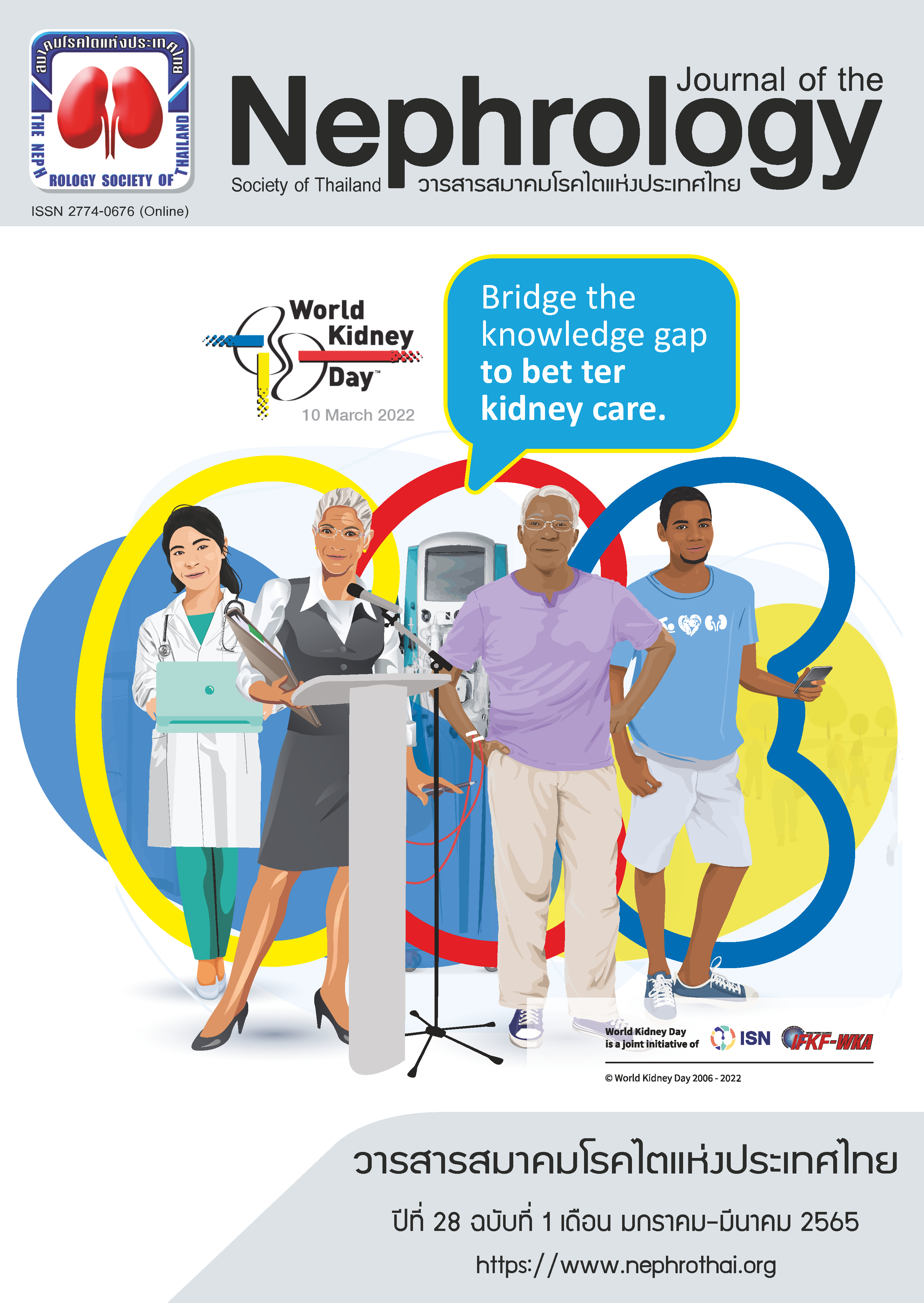โรคไตเรื้อรังชนิดไม่ทราบสาเหตุในพื้นที่เกษตรกรรม
Main Article Content
บทคัดย่อ
ในช่วง 20 ปีที่ผ่านมา มีรายงานความชุกของโรคไตเรื้อรังเพิ่มขึ้นในหลายประเทศ โดยเฉพาะประเทศเกษตรกรรม เช่น นิการากัว เอลซัลวาดอร์ ศรีลังกา และอินเดีย เป็นต้น ซึ่งนำไปสู่อุบัติการณ์การเสียชีวิตจากโรคไตเรื้อรังที่เพิ่มขึ้นตามไปด้วย ผู้ป่วยส่วนใหญ่เป็นเพศชาย มีอายุน้อย และส่วนใหญ่เป็นเกษตรกรไร่อ้อย โดยตรวจไม่พบสาเหตุอื่นๆของโรคไตเรื้อรัง เช่น โรคเบาหวานหรือความดันโลหิตสูง สาเหตุที่พบหลักฐานว่าอาจก่อให้เกิดโรค เช่น การใช้สารเคมีทางการเกษตร การทำงานกลางแดดเป็นเวลานาน ภาวะขาดน้ำ การปนเปื้อน ในแหล่งน้ำ การติดเชื้อเลปโตสไปโรซิส ยาสมุนไพร และปัจจัยทางพันธุกรรม เป็นต้น ในช่วงแรกส่วนใหญ่ไม่มีอาการ ตรวจพบเมื่อมีการดำเนินโรคไปมากแล้ว โดยลักษณะทางพยาธิวิทยาพบความผิดปกติแบบเรื้อรังที่เนื้อเยื่อรอบไตและท่อหน่วยไตเป็นหลัก การรักษาจึงเป็นเพียงการรักษาโรคไตเรื้อรังและการรักษาตามอาการ การศึกษาเกี่ยวกับสาเหตุของโรคไตเรื้อรังจึงมีความสำคัญเนื่องจากจะส่งผลให้สามารถป้องกันการเกิดโรคหรือชะลอการดำเนินโรคได้อย่างมีประสิทธิภาพมากขึ้นในอนาคต บทความนี้จะกล่าวถึงโรคไตเรื้อรังชนิดไม่ทราบสาเหตุ ทั้งในด้านระบาดวิทยา ลักษณะที่พบในพื้นที่ถิ่นของโรคบริเวณต่าง ๆ อาการและอาการแสดงทั้งในระยะเฉียบพลันและระยะเรื้อรัง ลักษณะทางพยาธิวิทยา สาเหตุที่เป็นไปได้ การรักษา และแนวทางการป้องกันโรคในระดับต่าง ๆ
Article Details

อนุญาตภายใต้เงื่อนไข Creative Commons Attribution-NonCommercial-NoDerivatives 4.0 International License.
บทความนี้ตีพิมพ์ภายไต้การอนุญาต CC BY-NC-ND 4.0 ซึ่งอนุญาตให้สามารถใช้บทความนี้พื่อวัตถุประสงค์ใดๆ ก็ตามที่ไม่ใช่เชิงพาณิชย์ โดยต้องมีการอ้างถึงที่มาของบทความอย่างครบถ้วน ใครก็ตามสามารถคัดลอกและแจกจ่ายทุกส่วนของบทความนี้โดยไม่ต้องขออนุญาตจากผู้ประพันธ์หรือสมาคมโรคไตแห่งประเทศไทย
เอกสารอ้างอิง
Mortality GBD, Causes of Death C. Global, regional, and national age-sex specific all-cause and cause-specific mortality for 240 causes of death, 1990-2013: a systematic analysis for the Global Burden of Disease Study 2013. Lancet. 2015;385(9963): 117-71.
Foreman KJ, Marquez N, Dolgert A, Fukutaki K, Fullman N, McGaughey M, et al. Forecasting life expectancy, years of life lost, and all-cause and cause-specific mortality for 250 causes of death: reference and alternative scenarios for 2016–40 for 195 countries and territories. Lancet. 2018;392(10159):2052-90.
Anandagoda N, Lord GM. Preventing aristolochic acid nephropathy. Clin J Am Soc Nephrol. 2015;10(2): 167-8.
Torres C AA, González M, López I, Jakobsson K, Elinder CG, Lundberg I, et al. Decreased kidney function of unknown cause in Nicaragua: a community-based survey. Am J Kidney Dis. 2010;55(3):485-96.
Wesseling C, van Wendel de Joode B, Crowe J, Rittner R, Sanati NA, Hogstedt C, et al. Mesoamerican nephropathy: geographical distribution and time trends of chronic kidney disease mortality between 1970 and 2012 in Costa Rica. Occup Environ Med. 2015;72(10):714-21.
Ordunez P, Nieto FJ, Martinez R, Soliz P, Giraldo GP, Mott SA, et al. Chronic kidney disease mortality trends in selected Central America countries, 1997-2013: clues to an epidemic of chronic interstitial nephritis of agricultural communities. J Epidemiol Community Health. 2018;72(4):280-6.
Orantes CM HR, Almaguer M, Brizuela EG, Hernández CE, Bayarre H, Amaya JC, et al. Chronic kidney disease and associated risk factors in the Bajo Lempa Region of El Salvador: Nefrolempa Study, 2009. MEDICC Review. 2011;13(4):14-22.
Peraza S, Wesseling C, Aragon A, Leiva R, García-Trabanino RA, Torres C, et al. Decreased kidney function among agricultural workers in El Salvador. Am J Kidney Dis. 2012;59(4):531-40.
López-Marín L CY, García XA, Flores WM, García YM, Herrera R, Almaguer M, et al. Histopathology of chronic kidney disease of unknown etiology in Salvadoran agricultural communities. MEDICC Rev. 2014;16(2):49-54.
Fischer RSB, Vangala C, Truong L, Mandayam S, Chavarria D, Granera Llanes OM, et al. Early detection of acute tubulointerstitial nephritis in the genesis of Mesoamerican nephropathy. Kidney Int. 2018;93(3):681-90.
Athuraliya NT AT, Amerasinghe PH, Kumarasiri R, Bandara P, Karunaratne U, Milton AH, et al. Uncertain etiologies of proteinuric-chronic kidney disease in rural Sri Lanka. Kidney Int. 2011;80:1212-21.
Wanigasuriya KP, Peiris-John RJ, Wickremasinghe R, Hittarage A. Chronic renal failure in North Central Province of Sri Lanka: an evironmentally induced disease. Trans R Soc Trop Med Hyg. 2007;101(10):1013-7.
Wijkstrom J, Jayasumana C, Dassanayake R, Priyawardane N, Godakanda N, Siribaddana S, et al. Morphological and clinical findings in Sri Lankan patients with chronic kidney disease of unknown cause (CKDu): Similarities and differences with Mesoamerican Nephropathy. PLoS One. 2018;13(3):e0193056.
Jayasumana C, Orantes C, Herrera R, Almaguer M, Lopez L, Silva LC, et al. Chronic interstitial nephritis in agricultural communities: a worldwide epidemic with social, occupational and environmental determinants. Nephrol Dial Transplant. 2017;32(2):234-41.
Wijewickrama ES, Gunawardena N, Jayasinghe S, Herath C. CKD of unknown etiology (CKDu) in Sri Lanka: A multilevel clinical case definition for surveillance and epidemiological studies. Kidney Int Rep. 2019;4(6):781-5.
Tatapudi RR, Rentala S, Gullipalli P, Komarraju AL, Singh AK, Tatapudi VS, et al. High Prevalence of CKD of unknown etiology in Uddanam, India. Kidney Int Rep. 2019;4(3):380-9.
Ingsathit A, Thakkinstian A, Chaiprasert A, Sangthawan P, Gojaseni P, Kiattisunthorn K, et al. Prevalence and risk factors of chronic kidney disease in the Thai adult population: Thai SEEK study. Nephrol Dial Transplant. 2010;25(5):1567-75.
Jayasumana C, Gunatilake S, Senanayake P. Glyphosate, hard water and nephrotoxic metals: are they the culprits behind the epidemic of chronic kidney disease of unknown etiology in Sri Lanka? Int J Environ Res Public Health. 2014;11(2):2125-47.
Gunatilake S, Seneff S, Orlando L. Glyphosate's synergistic toxicity in combination with other factors as a cause of chronic kidney disease of unknown origin. Int J Environ Res Public Health. 2019;16(15):2734.
Jayasumana C, Gunatilake S, Siribaddana S. Simultaneous exposure to multiple heavy metals and glyphosate may contribute to Sri Lankan agricultural nephropathy. BMC Nephrol. 2015;16:103.
Vervaet BA, Nast CC, Jayasumana C, Schreurs G, Roels F, Herath C, et al. Chronic interstitial nephritis in agricultural communities is a toxin-induced proximal tubular nephropathy. Kidney Int. 2020; 97(2):350-369.
Gonzalez-Quiroz M, Smpokou ET, Silverwood RJ, Camacho A, Faber D, Garcia BR, et al. Decline in kidney function among apparently healthy young adults at risk of mesoamerican nephropathy. J Am Soc Nephrol. 2018;29(8):2200-12.
Herath C, Jayasumana C, De Silva P, De Silva PHC, Siribaddana S, De Broe ME. Kidney diseases in agricultural communities: a case against heat-stress nephropathy. Kidney Int Rep. 2018;3(2):271-80.
Schneider MC, Najera P, Aldighieri S, Bacallao J, Soto A, Marquino W, et al. Leptospirosis outbreaks in Nicaragua: identifying critical areas and exploring drivers for evidence-based planning. Int J Environ Res Public Health. 2012;9(11):3883-910.
Nanayakkara S, Senevirathna ST, Abeysekera T, Chandrajith R, Ratnatunga N, Gunarathne ED, et al. An integrative study of the genetic, social and environmental determinants of chronic kidney disease characterized by tubulointerstitial damages in the North Central Region of Sri Lanka. J Occup Health. 2014;56(1):28-38.


